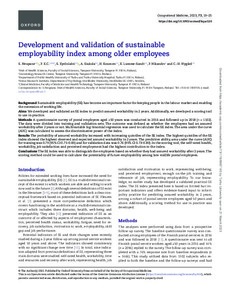Development and validation of sustainable employability index among older employees
Neupane Sukadeo; Prakash K.C.; Kyrönlahti Saila; Siukola Anna; Kosonen Heidi; Lumme-Sandt Kirsi; Nikander Pia; Nygard Clas-Hakan
https://urn.fi/URN:NBN:fi-fe2023032232755
Tiivistelmä
Background Sustainable employability (SE) has become an important factor for keeping people in the labour market and enabling the extension of working life.
Aims We developed and validated an SE index to predict assured workability in 2 years. Additionally, we developed a scoring tool to use in practice.
Methods A questionnaire survey of postal employees aged >= 50 years was conducted in 2016 and followed up in 2018 (n = 1102). The data were divided into training and validation sets. The outcome was defined as whether the employees had an assured workability after 2 years or not. Multivariable log-binomial regression was used to calculate the SE index. The area under the curve (AUC) was calculated to assess the discriminative power of the index.
Results The probability of assured workability increased with increasing quintiles of the SE index. The highest quintiles of the SE index showed the highest observed and expected assured workability in 2 years. The predictive ability, area under the curve (AUC) for training was 0.79 (95% CI 0.75-0.83) and for validation data was 0.76 (95% CI 0.73-0.80). In the scoring tool, the self-rated health, workability, job satisfaction and perceived employment had the highest contribution to the index.
Conclusions The SE index was able to distinguish the employees based on whether they had assured workability after 2 years. The scoring method could be used to calculate the potentiality of future employability among late midlife postal employees.
Kokoelmat
- Rinnakkaistallenteet [27094]
